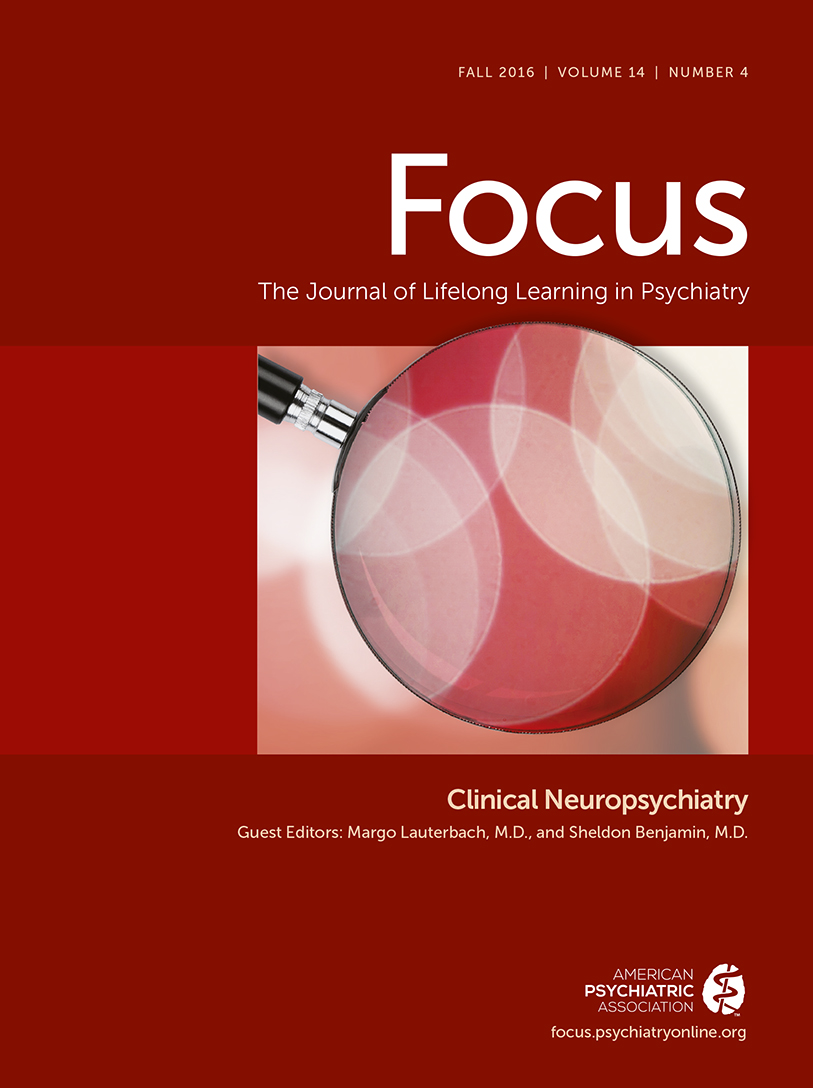Abstracts: Clinical Neuropsychiatry
Frontotemporal Dementia and Psychiatric Illness: Emerging Clinical and Biological Links in Gene Carriers.
Am J Geriatr Psychiatry 2016 Feb; 24(2):107–116
OBJECTIVE: To describe psychiatric presentations in individuals with genetic mutations causing frontotemporal dementia (FTD). DESIGN: Case descriptions from five carriers of FTD-related gene mutations with symptoms associated with non-neurodegenerative psychiatric disease. SETTING: A comprehensive research program investigating genetic and non-genetic FTD at the University of California, San Francisco Memory and Aging Center. PARTICIPANTS: Three proband and two non-proband gene carriers. MEASUREMENTS: Medical history and neurological examination, neuropsychological testing, magnetic resonance and/or positron emission tomography imaging, and a genetic analysis to screen for dementia-related mutations. Genetic status was unknown at the time of initial evaluation. RESULTS: The chosen cases are illustrative of the variety of presentations of psychiatric symptoms in FTD gene carriers. In some cases, a non-neurodegenerative psychiatric illness was diagnosed based on specific symptoms, but the diagnosis may have been inappropriate based on the overall syndrome. In other cases, symptoms closely resembling those seen in non-neurodegenerative psychiatric illness did occur, in some cases immediately preceding the development of dementia, and in other cases developing a decade prior to dementia symptoms. CONCLUSIONS: Psychiatric symptoms in FTD gene carriers can be very similar to those seen in non-neurodegenerative psychiatric illness. Psychiatric symptoms with atypical features (e.g., late-life onset, insidiously worsening course) should prompt careful assessment for neurodegenerative disease. Guidelines for such an assessment should be established.
Copyright © 2016 American Association for Geriatric Psychiatry. Published by Elsevier Inc. All rights reserved.
The Links Between Stress and Depression: Psychoneuroendocrinological, Genetic, and Environmental Interactions.
J Neuropsychiatry Clin Neurosci. 2016 Spring;28(2):77–88
The role of stress in the origin and development of depression may be conceived as the result of multiple converging factors, including the chronic effect of environmental stressors and the long-lasting effects of stressful experiences during childhood, all of which may induce persistent hyperactivity of the hypothalamic-pituitary-adrenal axis. These changes, including increased availability of corticotropin-releasing factor and cortisol, are also associated with hyperactivity of the amygdala, hypoactivity of the hippocampus, and decreased serotonergic neurotransmission, which together result in increased vulnerability to stress. The role of other monoaminergic neurotransmitters, genetic polymorphisms, epigenetic mechanisms, inflammatory processes, and altered cognitive processing has also been considered in the development of a comprehensive model of the interactions between different factors of vulnerability. Further understanding of the underlying mechanisms that link these factors may contribute significantly to the development of more effective treatments and preventive strategies in the interface between stress and mood disorders.
Reprinted with Permission from American Psychiatric Association Publishing
Illuminating Circuitry Relevant to Psychiatric Disorders with Optogenetics.
Curr Opin Neurobiol. 2015 Feb;30:9–16
The brain's remarkable capacity to generate cognition and behavior is mediated by an extraordinarily complex set of neural interactions that remain largely mysterious. This complexity poses a significant challenge in developing therapeutic interventions to ameliorate psychiatric disease. Accordingly, few new classes of drugs have been made available for patients with mental illness since the 1950s. Optogenetics offers the ability to selectively manipulate individual neural circuit elements that underlie disease-relevant behaviors and is currently accelerating the pace of preclinical research into neurobiological mechanisms of disease. In this review, we highlight recent findings from studies that employ optogenetic approaches to gain insight into normal and aberrant brain function relevant to mental illness. Emerging data from these efforts offers an exquisitely detailed picture of disease-relevant neural circuits in action, and hints at the potential of optogenetics to open up entirely new avenues in the treatment of psychiatric disorders.
Copyright © 2014 Elsevier Ltd. All rights reserved.
Network Dysfunction in Alzheimer's Disease and Frontotemporal Dementia: Implications for Psychiatry.
Biol Psychiatry. 2014 Apr 1;75(7):565–573
Structural and functional connectivity methods are changing how researchers conceptualize and explore neuropsychiatric disease. Here, we summarize emerging evidence of large-scale network dysfunction in Alzheimer's disease and behavioral variant frontotemporal dementia, focusing on the divergent impact these disorders have on the default mode network and the salience network. We update a working model for understanding the functions of these networks within a broader anatomical context and highlight the relevance of this model for understanding psychiatric illness. Finally, we look ahead to persistent challenges in the application of network-based imaging methods to patients with Alzheimer's disease, behavioral variant frontotemporal dementia, and other neuropsychiatric conditions. Recent advances and persistent needs are discussed, with an eye toward anticipating the hurdles that must be overcome for a network-based framework to clarify the biology of psychiatric illness and aid in the drug discovery process.
Copyright © 2014 Society of Biological Psychiatry. Published by Elsevier Inc. All rights reserved.
How Do You Feel--Now? The Anterior Insula and Human Awareness.
Nat Rev Neurosci. 2009 Jan;10(1):59–70
The anterior insular cortex (AIC) is implicated in a wide range of conditions and behaviours, from bowel distension and orgasm, to cigarette craving and maternal love, to decision making and sudden insight. Its function in the re-representation of interoception offers one possible basis for its involvement in all subjective feelings. New findings suggest a fundamental role for the AIC (and the von Economo neurons it contains) in awareness, and thus it needs to be considered as a potential neural correlate of consciousness.



